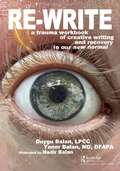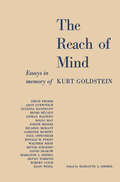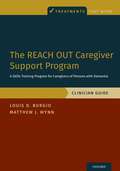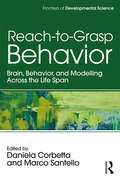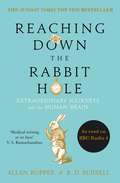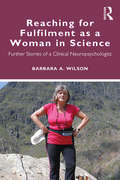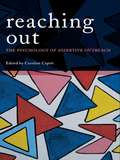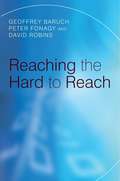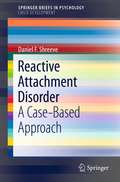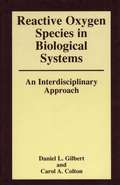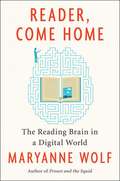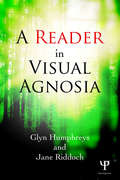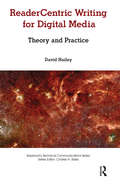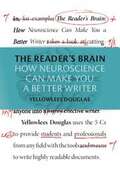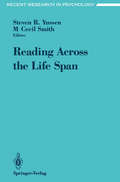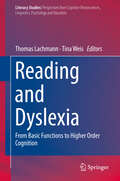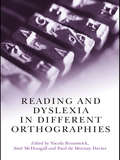- Table View
- List View
Re-Write: A Trauma Workbook of Creative Writing and Recovery in Our New Normal
by Duygu Balan Yener BalanAttachment theory-based treatments including depth psychology, somatic psychology, holistic therapy, and Eye Movement Desensitization and Reprocessing (EMDR) are becoming even more popular and desired by clinicians, health systems, and the patients they care for. Up until recently, cognitive behavioral therapy and medication management were the mainstays for trauma-informed care, although we are witnessing a demand for a more somatic, holistic, and, therefore, deeper level of treatment to target attachment injury and change/re-write the trauma narrative. This book provides the response and tools to meet this current need. Due to the pandemic, lockdowns, and significant changes in our stability, the economy, sense of belonging, and community, there is a heightened level of triggering which has resulted in multifactorial trauma responses. The devastating traumatic impact spans nations, ages, and socioeconomic statuses. Unfortunately, domestic violence, child abuse, substance use, medical trauma, self-injury, suicide, and violence turned outwards have all increased significantly in the past two years. This workbook focuses on the healing journey of the trauma survivor, utilizing easy-to-use methodologies for long-lasting effects. It includes various exercises, writing prompts, coping mechanisms, and soothing techniques with the intention of allowing the person to create an individualized experience. This empowers the person to go in the order they choose, experiment with different techniques from different modalities, and find the ones that meet their needs the best. The authors also address generational trauma, societal trauma, and trauma at the family and individual levels, and their work can be used in conjunction with a clinical treatment plan or by the end user. Re-Write: A Trauma Workbook of Creative Writing and Recovery in Our New Normal employs practical strategies using evidence-based methodologies with psychological theory within a human-centered design framework.
The REACH OUT Caregiver Support Program: A Skills Training Program for Caregivers of Persons with Dementia, Clinician Guide (Treatments That Work)
by Louis D. Burgio Matthew J. WynnOlder adults increasingly rely on family members or friends (i.e., informal caregivers) for needed care and support as they age. Family caregivers typically assume their caregiving role willingly and reap personal fulfilment from helping a loved one, developing new skills, and strengthening family relationships. For these benefits, however, caregivers often sacrifice their own health and well-being. Depression, anxiety, poor physical health, and compromised immune function are more common among family caregivers than in adults not providing such care. The REACH OUT Caregiver Support Program offers a multi-component, tailored, and flexible intervention for caregivers of people with dementia that is focused on the evidence-based therapeutic strategy of problem solving. This practical volume is designed to guide clinicians through the process of implementing REACH OUT (Resources for Enhancing Alzheimer's Caregiver Health: Offering Useful Treatments) and to provide them with necessary tools to share with caregivers, with the goal of enhancing caregiver physical and mental health. Five common risk areas (home safety, caregiver health, social support, challenging behaviors, and emotional well-being) are described in the manual, and interventions are outlined that respect the nuances of each risk area. By beginning with an individualized risk assessment and being flexible to the needs and issues of the caregiver, the REACH OUT intervention helps clinicians identify risk areas and provides caregivers with tailored action plans to reduce risk and promote well-being.
The REACH OUT Caregiver Support Program: A Skills Training Program for Caregivers of Persons with Dementia, Clinician Guide (Treatments That Work)
by Louis D. Burgio Matthew J. WynnOlder adults increasingly rely on family members or friends (i.e., informal caregivers) for needed care and support as they age. Family caregivers typically assume their caregiving role willingly and reap personal fulfilment from helping a loved one, developing new skills, and strengthening family relationships. For these benefits, however, caregivers often sacrifice their own health and well-being. Depression, anxiety, poor physical health, and compromised immune function are more common among family caregivers than in adults not providing such care. The REACH OUT Caregiver Support Program offers a multi-component, tailored, and flexible intervention for caregivers of people with dementia that is focused on the evidence-based therapeutic strategy of problem solving. This practical volume is designed to guide clinicians through the process of implementing REACH OUT (Resources for Enhancing Alzheimer's Caregiver Health: Offering Useful Treatments) and to provide them with necessary tools to share with caregivers, with the goal of enhancing caregiver physical and mental health. Five common risk areas (home safety, caregiver health, social support, challenging behaviors, and emotional well-being) are described in the manual, and interventions are outlined that respect the nuances of each risk area. By beginning with an individualized risk assessment and being flexible to the needs and issues of the caregiver, the REACH OUT intervention helps clinicians identify risk areas and provides caregivers with tailored action plans to reduce risk and promote well-being.
Reach-to-Grasp Behavior: Brain, Behavior, and Modelling Across the Life Span (Frontiers of Developmental Science)
by Daniela Corbetta Marco SantelloReaching for objects in our surroundings is an everyday activity that most humans perform seamlessly a hundred times a day. It is nonetheless a complex behavior that requires the perception of objects’ features, action selection, movement planning, multi-joint coordination, force regulation, and the integration of all of these properties during the actions themselves to meet the successful demands of extremely varied task goals. Even though reach-to-grasp behavior has been studied for decades, it has, in recent years, become a particularly growing area of multidisciplinary research because of its crucial role in activities of daily living and broad range of applications to other fields, including physical rehabilitation, prosthetics, and robotics. This volume brings together novel and exciting research that sheds light into the complex sensory-motor processes involved in the selection and production of reach-to-grasp behaviors. It also offers a unique life-span and multidisciplinary perspective on the development and multiple processes involved in the formation of reach-to-grasp. It covers recent and exciting discoveries from the fields of developmental psychology and learning sciences, neurophysiology and brain sciences, movement sciences, and the dynamic field of developmental robotics, which has become a very active applied field relying on biologically inspired models. This volume is a rich and valuable resource for students and professionals in all of these research fields, as well as cognitive sciences, rehabilitation, and other applied sciences.
Reach-to-Grasp Behavior: Brain, Behavior, and Modelling Across the Life Span (Frontiers of Developmental Science)
by Daniela Corbetta Marco SantelloReaching for objects in our surroundings is an everyday activity that most humans perform seamlessly a hundred times a day. It is nonetheless a complex behavior that requires the perception of objects’ features, action selection, movement planning, multi-joint coordination, force regulation, and the integration of all of these properties during the actions themselves to meet the successful demands of extremely varied task goals. Even though reach-to-grasp behavior has been studied for decades, it has, in recent years, become a particularly growing area of multidisciplinary research because of its crucial role in activities of daily living and broad range of applications to other fields, including physical rehabilitation, prosthetics, and robotics. This volume brings together novel and exciting research that sheds light into the complex sensory-motor processes involved in the selection and production of reach-to-grasp behaviors. It also offers a unique life-span and multidisciplinary perspective on the development and multiple processes involved in the formation of reach-to-grasp. It covers recent and exciting discoveries from the fields of developmental psychology and learning sciences, neurophysiology and brain sciences, movement sciences, and the dynamic field of developmental robotics, which has become a very active applied field relying on biologically inspired models. This volume is a rich and valuable resource for students and professionals in all of these research fields, as well as cognitive sciences, rehabilitation, and other applied sciences.
Reaching and Teaching the Child with Autism Spectrum Disorder: Using Learning Preferences and Strengths
by Heather MacKenzieThis book provides a positive approach to understanding and educating children on the autism spectrum. The book gives greater insight into the perspective and behavior of a child with autism and explores how the child's learning preferences, strengths and interests can be used to facilitate learning and enhance motivation.
Reaching Down the Rabbit Hole: Extraordinary Journeys into the Human Brain
by Dr Allan Ropper Brian David BurrellSHORTLISTED FOR THE 2016 BMA MEDICAL BOOK AWARDS One of the world's leading neurologists reveals the extraordinary stories behind some of the brain disorders that he and his staff at the Harvard Medical School endeavour to treat.What is it like to try to heal the body when the mind is under attack? In this gripping and illuminating book, Dr Allan Ropper reveals the extraordinary stories behind some of the life-altering afflictions that he and his staff are confronted with at the Neurology Unit of Harvard's Brigham and Women's Hospital. Like Alice in Wonderland, Dr Ropper inhabits a place where absurdities abound: a sportsman who starts spouting gibberish; an undergraduate who suddenly becomes psychotic; a mother who has to decide whether a life locked inside her own head is worth living. How does one begin to treat such cases, to counsel people whose lives may be changed forever? Dr Ropper answers these questions by taking the reader into a world where lives and minds hang in the balance.
Reaching for Fulfilment as a Woman in Science: Further Stories of a Clinical Neuropsychologist
by Barbara A. WilsonThis vivid memoir presents adventures from the life of Barbara A. Wilson, an internationally honoured scientist who played an influential role in the development of neuropsychological rehabilitation at a time when the scientific field was dominated by men. As a follow-up to the highly successful Story of a Clinical Neuropsychologist, this book includes a host of memories, both personal and professional, which focus on Barbara’s development of her career as a woman in science. From childhood recollections and travels in Africa, to lifetime achievement awards and the restrictions of global pandemics, Barbara tells the story of her full and varied life and her unparalleled career in neuropsychological rehabilitation. Her book indicates that one can lead a meaningful and full life even after one of the most awful of losses, the death of a child, and also emphasizes the need to stick to one’s principles in trying times. The result is an unparalleled insight into the life of a clinical neuropsychologist, which can encourage the next generation of professionals who are trying to balance career, international travel and family, as well as inspire any girls interested in entering the world of science.
Reaching for Fulfilment as a Woman in Science: Further Stories of a Clinical Neuropsychologist
by Barbara A. WilsonThis vivid memoir presents adventures from the life of Barbara A. Wilson, an internationally honoured scientist who played an influential role in the development of neuropsychological rehabilitation at a time when the scientific field was dominated by men. As a follow-up to the highly successful Story of a Clinical Neuropsychologist, this book includes a host of memories, both personal and professional, which focus on Barbara’s development of her career as a woman in science. From childhood recollections and travels in Africa, to lifetime achievement awards and the restrictions of global pandemics, Barbara tells the story of her full and varied life and her unparalleled career in neuropsychological rehabilitation. Her book indicates that one can lead a meaningful and full life even after one of the most awful of losses, the death of a child, and also emphasizes the need to stick to one’s principles in trying times. The result is an unparalleled insight into the life of a clinical neuropsychologist, which can encourage the next generation of professionals who are trying to balance career, international travel and family, as well as inspire any girls interested in entering the world of science.
Reaching Out: The Psychology of Assertive Outreach
by Caroline CupittAssertive outreach is a means of helping people with serious and persistent mental health difficulties who have not engaged with conventional mental health services. Reaching Out examines the application of psychological approaches in assertive outreach – a process which involves forming new relationships and offering hope to people who have been alienated from traditional methods. Reaching Out begins with a discussion of topics including: engagement the team approach assessments team case formulation managing stress and burnout for staff. The second half of the book focuses on the task of delivering psychological therapies and considers a range of models including psychodynamic therapy, family therapy, cognitive behaviour therapy and community approaches. Reaching Out: The Psychology of Assertive Outreach demonstrates that the relationship between staff and service users is essential to the process of recovery and personal growth. The approach will apply not only to assertive outreach teams, but also to clinical psychologists, counsellors and other mental health professionals who are interested in psychological approaches to outreach work.
Reaching Out: The Psychology of Assertive Outreach
by Caroline CupittAssertive outreach is a means of helping people with serious and persistent mental health difficulties who have not engaged with conventional mental health services. Reaching Out examines the application of psychological approaches in assertive outreach – a process which involves forming new relationships and offering hope to people who have been alienated from traditional methods. Reaching Out begins with a discussion of topics including: engagement the team approach assessments team case formulation managing stress and burnout for staff. The second half of the book focuses on the task of delivering psychological therapies and considers a range of models including psychodynamic therapy, family therapy, cognitive behaviour therapy and community approaches. Reaching Out: The Psychology of Assertive Outreach demonstrates that the relationship between staff and service users is essential to the process of recovery and personal growth. The approach will apply not only to assertive outreach teams, but also to clinical psychologists, counsellors and other mental health professionals who are interested in psychological approaches to outreach work.
Reaching the Hard to Reach: Evidence-based Funding Priorities for Intervention and Research
by Geoffrey Baruch Peter Fonagy David RobinsSocial inequality and social disadvantage provide an all too fertile soil that sustains the majority of the serious mental health problems suffered by children in our society. The complexity of the issues clinicians routinely encounter in working with children with mental health problems is widely acknowledged. However, few books concern themselves with how such difficult populations can be effectively approached and the strategies that are likely to deliver effective treatment to them. This book, based on a highly successful seminar for grant-giving children's charities held at the Anna Freud Centre and sponsored by John Lyon's Charity, provides pragmatic solutions to this major therapeutic challenge of our age. The chapters bridge statutory and voluntary initiatives and are held firmly together by the commitment to evidence-based, systematically offered, programmatic and innovative approaches that can help those who, although hard to reach, are in greatest need of our efforts: the socially excluded children and families in our society. As such, this book will be invaluable to psychologists, psychotherapists, counselors and family therapists.
Reactions to Psychotropic Medication
by Frank L. TornatoreAfter thousands of clinical trials, the efficacy of psychotropic drugs in the treatment of psychiatric disorders has become well established. However, the very success of these drugs has meant that many patients with chronic illnesses will receive them for a significant part of their lifetime. Side effects and other adverse reactions are an unfortunate but unavoidable component of successful pharmacotherapy. In deed, the main emphasis in new drug development is often on the search for compounds that have fewer side effects, although no one has as yet found an effective drug without them. Therefore, it is important for clinicians to be aware of side effect reaction profiles, because they are often a major determining factor in the choice of therapy. After more than three decades of major breakthroughs in the development of psychotropic drugs, reactions to these medications are still frequently reported in the current liter ature, and information about well-known reactions is con stantly refined. This book is an attempt to systematically collect and organize this large body of data and present it in an easy-to-use form. All chapters follow the same reaction oriented logic, and each important reaction is discussed using the same consistent subdivisions. The more clinically impor tant reactions appear in the body of each chapter; the more unusual or rarely reported reactions are briefly characterized in the miscellaneous section at the end of each chapter.
Reactive Attachment Disorder: A Case-Based Approach (SpringerBriefs in Psychology)
by Daniel F. ShreeveA child’s close bond with mother, father, or guardian usually provides a foundation for trust in all future attachments. Children deprived of early and healthy dependency—who do not form normal attachment with their caregivers—may later suffer from Reactive Attachment Disorder (RAD). This childhood disorder is characterized by a general failure in social relationships resulting from pathogenic care.Although first included in the third edition of the Diagnostic and Statistical Manual (DSM-III) in 1980, RAD is one of the more uncommon and understudied forms of psychopathology. Reactive Attachment Disorder: A Case-Based Approach adds to a now growing research base, providing scholars and clinicians with a well-rounded analysis of RAD and suggested treatments. The case-based approach used in this Brief follows the representative case of “Jorge,” presented as unfolding over time and structured to illustrate challenges of diagnosis, to show examples of co-morbidity, and to provoke reflection on what questions may arise during treatment. Readers are asked to appraise the overlap with other clinical syndromes, the forms of psychotherapy which may apply, and the potential role of psychiatric medications as part of a comprehensive treatment plan.
Reactive Oxygen Species in Biological Systems: An Interdisciplinary Approach
by Carol Colton Daniel GilbertReactive oxygen species (ROS) which include free radicals, peroxides, singlet oxygen, ozone, and nitrogen monoxide and dioxide free radicals, is an area of intense research. This volume covers (1) the destruction of cellular function by ROS resulting in pathological states; (2) the protection by ROS of an organism against invading organisms that cause infections; and (3) the role of ROS in normal physiological processes. Designed for beginning graduate students, this book gives a concise overview of the field.
Reader, Come Home: The Reading Brain In A Digital World (PDF)
by Maryanne WolfA decade ago, Maryanne Wolf's Proust and the Squid revealed what we know about how the brain learns to read and how reading changes the way we think and feel. Since then, the ways we process written language have changed dramatically with many concerned about both their own changes and that of children. New research on the reading brain chronicles these changes in the brains of children and adults as they learn to read while immersed in a digitally dominated medium.
A Reader in Visual Agnosia
by Glyn Humphreys Jane RiddochThe case study of John has provided a unique insight into the nature of visual agnosia and more broadly into the underlying processes which support human vision. After suffering a stroke, John had problems in recognizing common objects, faces, seeing colours, reading and finding his way around his environment. A Reader in Visual Agnosia brings together the primary scientific papers describing the detailed investigations for each visual problem which the authors carried out with John, known as patient HJA. This work was summarised initially in To See But Not To See (1987), and 26 years later in A Case Study in Visual Agnosia Revisited (2013). The chapters are divided into 6 parts corresponding to the key areas of investigation: Integrative visual agnosia Perception of global form Face perception Colour perception Word recognition Changes over time Each part contains a short introduction, written by the two leading researchers who worked with John, which highlights the relations between the papers and demonstrates the pathway of the case analysis. The book will be invaluable to students and researchers in visual cognition, cognitive neuropsychology and vision neuroscience.
A Reader in Visual Agnosia: To See But Not To See
by Glyn Humphreys Jane RiddochThe case study of John has provided a unique insight into the nature of visual agnosia and more broadly into the underlying processes which support human vision. After suffering a stroke, John had problems in recognizing common objects, faces, seeing colours, reading and finding his way around his environment. A Reader in Visual Agnosia brings together the primary scientific papers describing the detailed investigations for each visual problem which the authors carried out with John, known as patient HJA. This work was summarised initially in To See But Not To See (1987), and 26 years later in A Case Study in Visual Agnosia Revisited (2013). The chapters are divided into 6 parts corresponding to the key areas of investigation: Integrative visual agnosia Perception of global form Face perception Colour perception Word recognition Changes over time Each part contains a short introduction, written by the two leading researchers who worked with John, which highlights the relations between the papers and demonstrates the pathway of the case analysis. The book will be invaluable to students and researchers in visual cognition, cognitive neuropsychology and vision neuroscience.
Readercentric Writing for Digital Media: Theory and Practice (Baywood's Technical Communications)
by David HaileyThis book presents an altogether new approach to writing and evaluating writing in digital media. It suggests that usability theory provides few tools for evaluating content, because usability theory assumes only one kind of writing on the Internet. The author suggests three models: user-centric (usability model), persuasion-centric (encouraging the reader to linger and be persuaded--Canon camera ads), and quality-centric (encouraging the reader to linger and learn or be entertained because of the quality of the writing--NASA.gov and YouTube). Designed for professional writers and writing students, this text provides a rubric for writing in digital media, but more importantly, it provides a rubric and vocabulary for identifying and explaining problems in copy that already exists. The Internet has become a pastiche of cut-and-paste content, often placed by non-writers to fill space for no particular reason or by computers with no oversight from humans (e.g., Amazon.com). Because these snippets are typically on topic (but often for the wrong purpose or audience), professional writers have difficulty identifying the problems and an even harder time explaining them. Finding an effective tool for identifying and explaining problems in digital content becomes a particularly important problem as writers increasingly struggle with growing complications in complex information systems (systems that create and manage their own content with little human intervention). Being able to look at a body of copy and immediately see that it is problematic is an important skill that is lacking in a surprising number of professional writers.
Readercentric Writing for Digital Media: Theory and Practice (Baywood's Technical Communications)
by David HaileyThis book presents an altogether new approach to writing and evaluating writing in digital media. It suggests that usability theory provides few tools for evaluating content, because usability theory assumes only one kind of writing on the Internet. The author suggests three models: user-centric (usability model), persuasion-centric (encouraging the reader to linger and be persuaded--Canon camera ads), and quality-centric (encouraging the reader to linger and learn or be entertained because of the quality of the writing--NASA.gov and YouTube). Designed for professional writers and writing students, this text provides a rubric for writing in digital media, but more importantly, it provides a rubric and vocabulary for identifying and explaining problems in copy that already exists. The Internet has become a pastiche of cut-and-paste content, often placed by non-writers to fill space for no particular reason or by computers with no oversight from humans (e.g., Amazon.com). Because these snippets are typically on topic (but often for the wrong purpose or audience), professional writers have difficulty identifying the problems and an even harder time explaining them. Finding an effective tool for identifying and explaining problems in digital content becomes a particularly important problem as writers increasingly struggle with growing complications in complex information systems (systems that create and manage their own content with little human intervention). Being able to look at a body of copy and immediately see that it is problematic is an important skill that is lacking in a surprising number of professional writers.
The Reader's Brain (PDF): How Neuroscience Can Make You A Better Writer
by Yellowlees DouglasHave you ever found yourself re-reading the same sentence four or five times and thought 'I should get more sleep'? Are you clueless as to why one paragraph just seems to 'flow' while you simply can't recall the contents of another? Guess what: you are not alone. Even the best writers fail to grasp why their writing works. The Reader's Brain is the first science-based guide to writing, employing cutting-edge research on how our minds process written language, to ensure your writing can be read quickly, assimilated easily, and recalled precisely - exactly what we need to transform anyone into a highly effective writer. Using the 5Cs - clarity, continuity, coherence, concision, and cadence - this book combines irreverent humour with easy-to-follow principles that will make readers perceive your sentences, paragraphs, and documents to be clear, concise, and effective.
Reading Across the Life Span (Recent Research in Psychology)
by Steven R. Yussen and M. Cecil SmithOne of the liveliest areas of research in the social sciences is reading. Scholarly activity is currently proceeding along a number of different disciplinary lines, addressing a multitude of questions and issues about reading. A short list of disciplines involved in the study of reading would include linguistics, psychology, education, history, and gerontology. Among the important questions being ad dressed are some long-standing concerns: How are reading skills acquired? What are the basic components of reading skill? How do skilled readers differ from less skilled ones? What are the best ways to approach instruction for different groups of readers-young beginning readers, poor readers with learning problems, and teenage and adult illiterates? How can reading skill best be measured-what standardized instruments and observational techniques are most useful? The large volume of textbooks and scholarly books that issue forth each year is clear evidence of the dynamic nature of the field. The purpose of this volume is to survey some of the best work going on in the field today and reflect what we know about reading as it unfolds across the life span. Reading is clearly an activity that spans each of our lives. Yet most accounts of it focus on some narrow period of development and fail to consider the range of questions that serious scholarship needs to address for us to have a richer under standing of reading. The book is divided into four parts.
Reading and Dyslexia: From Basic Functions to Higher Order Cognition (Literacy Studies #16)
by Thomas Lachmann Tina WeisIn this volume a group of well-known experts of the field cover topics ranging from basic visual and auditory information processing to higher order cognition in reading and dyslexia, from basic research to remediation approaches and from well-established theories to new hypotheses about reading acquisition and causes for its failure. Reading is one of the most intriguing feats human evolution ever came up with. There is no evolutionary basis for reading as such; reading is secondary to language and the result of a complex skill acquisition at the end of which almost all pre-existing cognitive functions are mobilized. With the right instruction and practice most people learn this skill smoothly. Some, however, have problems, despite same opportunities and general cognitive abilities. This developmental dyslexia results from a neuro developmental disorder leading to deficits in reading relevant information processing. But what deficits are these, and can they be trained?
Reading and Dyslexia in Different Orthographies
by Nicola BrunswickThis book provides a unique and accessible account of current research on reading and dyslexia in different orthographies. While most research has been conducted in English, this text presents cross-language comparisons to provide insights into universal aspects of reading development and developmental dyslexia in alphabetic and non-alphabetic languages. The book brings together contributions from a group of leading literacy researchers from around the world. It begins by examining the development of language skills in monolingual speakers of alphabetic and non-alphabetic languages; it then explores literacy acquisition in bilingual children learning to read in languages with different spelling-sound rules, including English, French, Greek, Welsh and Japanese. The second section is devoted to developmental dyslexia in monolingual and bilingual speakers of different languages and examines the impact of variations in orthography on the symptoms and aetiology of dyslexia. The final section explores the contribution of brain imaging to the study of impaired and unimpaired reading, giving an up-to-the-minute picture of how the brain deals with different languages and writing systems. This is ideal reading for advanced undergraduates and postgraduates who have an interest in language acquisition, reading and spelling, as well as speech and language therapists, teachers and special educational needs professionals.
